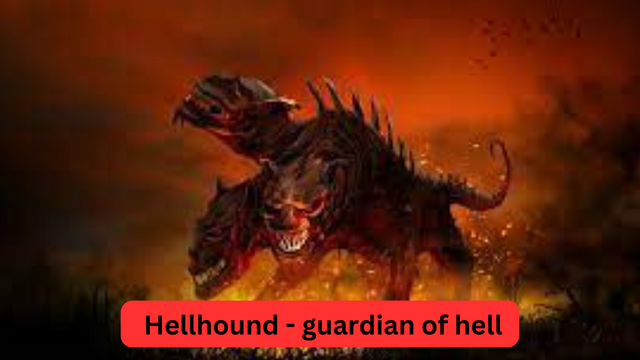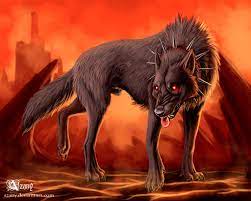Hellhound – guardian of hell

A Hellhound is a mythological hound that embodies a guardian or a servant of hell, the devil, or the underworld. Hellhounds occur in mythologies around the world, with the best-known examples being Cerberus from Greek mythology, Garmr from Norse mythology, the black dogs of English folklore, and the fairy hounds of Celtic mythology. Physical characteristics vary, but they are commonly black, abnormally overgrown, supernaturally strong, and often have red eyes or are accompanied by flames.

Depiction in France
In France, in AD 856 a black hound was said to materialize in a church even though the doors were shut. The church grew dark as it padded up and down the aisles as if looking for someone. The dog then vanished as suddenly as it had appeared. On mainland Normandy the Rongeur d’Os wanders the streets of Bayeux on winter nights as a phantom dog, gnawing on bones and dragging chains along with it. In Lower Brittany, there are stories of a ghost ship crewed by the souls of criminals with hellhounds set to guard them and inflict on them a thousand tortures.
Depiction in Germany
In Germany, it was believed that the devil would appear as a black hellhound, especially on Walpurgisnacht.
In Greece
In Greek mythology, Cerberus, often referred to as the hound of Hades, is a multi-headed dog that guards the gates of the Underworld to prevent the dead from leaving. He was the offspring of the monsters Echidna and Typhon and was usually described as having three heads, a serpent for a tail, and snakes protruding from multiple parts of his body.
Spain myths
In Catalan myth, Dip is an evil, black, hairy hound, an emissary of the Devil, who sucks people’s blood. Like other figures associated with demons in Catalan myth, he is lame in one leg. The dip is depicted on the escutcheon of Pratdip. In Galicia, the Urco was a giant black hound that led the Santa Compaña, a version of the Wild Hunt.
England
The myth is common across Great Britain in the form of the “black dogs” of English folklore. The earliest written record of the “hellhound” is in the 11th and 12th-century Peterborough version of the Anglo-Saxon Chronicle, which speaks of a “wild hunt” through the forest between Peterborough and Stamford.
Latin American
Black hellhounds with fiery eyes are reported throughout Latin America from Mexico to Argentina under a variety of names including the Perro Negro (Spanish for black dog), Nahual (Mexico), Huay Chivo, and Huay Pek (Mexico) – alternatively spelled Uay/Way /Waay Chivo/Pek, Cadejo (Central America), the Dog Familiar (Argentina) and the Lobizon (Paraguay and Argentina). They are usually said to be either incarnations of the Devil or a shape-changing sorcerer.
Arabia
Jinn, although not necessarily evil, but often thought of as malevolent entities, are thought to use black dogs as their mounts. The negative depiction of dogs probably derives from their close association with “eating the dead” (relishing bones) and digging out graves. The jinn likewise is often said to roam around graveyards and eat corpses. These characteristics relate to each other.
Indian depiction
The Mahākanha Jātaka of the Buddhist Pali Canon includes a story about a black hound named Mahākanha (Pali; lit. “Great black”). Led by the god Śakra in the guise of a forester, Mahākanha scares unrighteous people toward righteousness so that few people will be reborn in hell.
His appearance portends the moral degeneration of the human world when monks and nuns do not behave as they should and humanity has gone astray from ethical livelihood.
